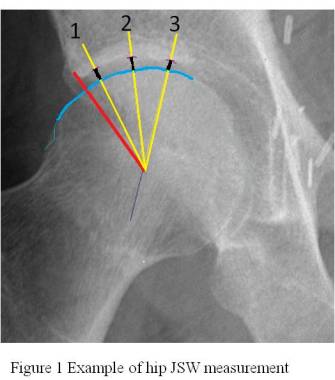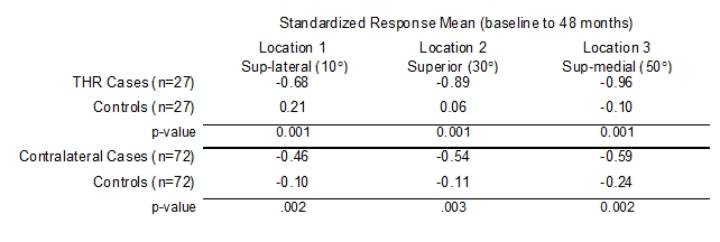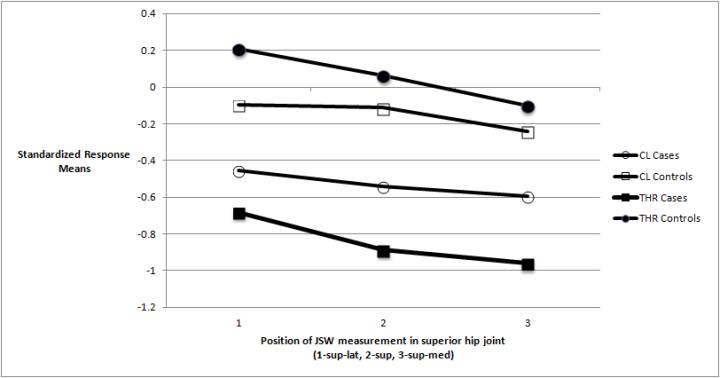Session Information
Session Type: Abstract Submissions (ACR)
Background/Purpose : Responsive measures of radiographic joint space width (JSW) in hip osteoarthritis (OA) are a major requirement for the evaluation of treatment interventions. The primary purpose of this study was to validate a semi-automated quantitative software tool for hip JSW by measuring responsiveness at 3 different fixed locations.
Methods: We used data from the Osteoarthritis Initiative (OAI), a longitudinal cohort study of knee OA. All OAI participants had standing AP radiographs at baseline and 48 month visits using a standardized protocol.
We used a nested case-control design, and had two case definitions. First, subjects who had a total hip replacement (THR) sometime after the 48 month visit (at 60 and 72 months) and available AP pelvic films at 0 and 48 months (n=27) were selected and matched (1:1) on sex and age (2 years) to subjects without a THR and no hip pain during the study period.
Second, a larger sample of cases was selected that included all subjects who had a THR at any point after baseline and had AP pelvis films at 0 and 48 months (n=72). The contralateral (CL) hip from the THR was designated the case hip, and subjects were matched (1:1) as above.
Measurements of superior hip JSW were made at 3 fixed locations (10°, 30° and 50° medial to a line from the femoral head centre to the outer edge of the acetabular roof – lateral line in Figure 1) and were facilitated by software that delineated the femoral head and found the acetabular margin along each of the 3 lines. A reader used software to correct margins if needed.
Statistical analysis. Sensitivity to change was estimated by the standardized response mean for change from baseline to 48 months. Paired t-tests were used to test statistical significance between cases and controls.
Results: The overall sample was 47% male, 91% Caucasian had a mean age of 64.2 and BMI of 27.9. The results are given in Table 1 and Figure 2. Significant differences were observed between cases and controls in both case-control groups. The superior medial location (position 3) was the most responsive.
Conclusion: Location 3 (sup-med) was the most responsive in all 4 groups and warrants further study. Location specific measures of JSW are potentially an improved method to assess hip OA.
We acknowledge NIH/NIAMS R01AR056664.
Disclosure:
C. Ratzlaff,
None;
J. W. Duryea,
None.
« Back to 2013 ACR/ARHP Annual Meeting
ACR Meeting Abstracts - https://acrabstracts.org/abstract/sensitivity-to-change-of-a-new-method-of-computer-measurement-of-hip-joint-space-width-performance-of-location-specific-measures-obtained-at-a-48-month-interval/



